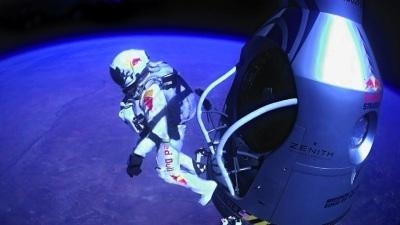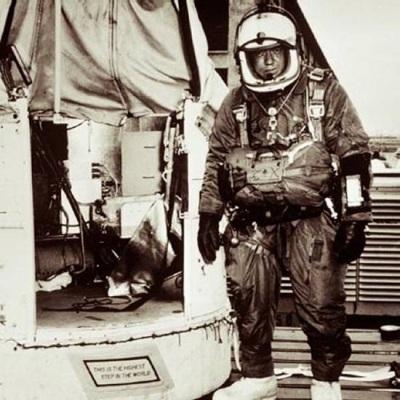Felix Baumgartner Latest In A (Short) Line Of High-Altitude Jumpers
By Wes Oleszewski
Just before dawn on October 14th, 2012 a balloon lifted off near Roswell, New Mexico. Aboard was extreme parachuter Felix Baumgartner. His goal, basically, was to smash three records. Garbed in a full pressure suit, Baumgartner was out to set a new record for the highest parachute jump as well as the longest free-fall and become the first person to break the sound barrier in flight without an aircraft.

Supporting the flight on the ground, the event’s sponsor, the makers of the Red Bull energy drink, had assembled a “mission control” center that added high-tech communications, video, and procedures to the flight. Fittingly, the capsule communicator (CAPCOM) who would be the sole person talking to Baumgartner would be Joe Kittinger.
To anyone interested in the history of people leaving the ground, Joe Kittinger’s name is one steeped in ballooning and parachuting history. On June 7th, 1957 he made the first manned high altitude balloon flight as a part of the Air Force’s High Man Project. On that mission he traveled up to 96,000 feet and landed in the gondola. In 1959 he again flew in a high altitude balloon as a part of Project Excelsior. That time he went up to 76,000 feet and returned to earth by free-fall and parachute. Less than a month later he again went aloft- this time to 74,700 feet and again jumped. Six months later he ascended in the Excelsior III balloon to 102,800 feet. Again Kittinger leaped from the gondola and skydived toward earth. After 13 seconds of pure free-fall, a small drogue chute deployed to stabilize him. That chute was used to prevent a problem that Kittinger had experienced on his first free-fall. His body tended to go into a high rate flat spin that was so dynamic it caused him to lose
consciousness. Only the auto-deploy system on his parachute saved his life. Thus, on his record setting flight, he dropped for 13 seconds then deployed the the drogue chute. His entire drop lasted a total of four minutes and 36 seconds before his main chute deployed. Kittinger, however, was not just a parachutist- he was foremost an Air Force test pilot and following his record-setting balloon flights he went back to flying and later volunteered for combat duty in Vietnam where he shot down one MiG and was later shot down himself; he spent 11 months as a POW. With a man like Joe Kittinger in support of his effort, Baumgartner was already one step ahead.

When it comes to the art and science of parachuting, Baumgartner himself was at the top of the pyramid long before he climbed aboard the Red Bull Stratos balloon. He began parachute jumping at the age of 16 and eventually became a part of his native Austria’s military demonstration and competition parachute team. Eventually he went on to BASE jumping and setting records for some of the most daring BASE jumps ever made.
Interestingly, the ATA Aerospace launch team that released the Red Bull Stratos balloon works for the same company that launched Kittinger a half century earlier. Largely because of their expert support, Baumgartner’s ascent went normally ... with the exception of a defect in his helmet’s visor. The heating elements intended to keep the visor from fogging up malfunctioned. The issue was worked right up to the egress and jump, but no solution was found. Mission control elected to simply live with the problem. As the balloon reached 128,000 feet, Kittinger began going over the egress checklist with Baumgartner. Shortly after the cabin of the gondola was de-pressurized, there came a moment of concern as Kittinger was sending commands up to Baumgartner who appeared to be unresponsive and confused. Although nothing was said, the thought came to mind that hypoxia may be taking place. It turned out to apparently simply be ratty communications as Kittinger had to firmly remind Baumgartner that
“you have to answer me Felix.” Later in the egress itself, Baumgartner actually had to respond to the ground by giving thumbs-up at critical moments.
In a spectacle unlike any ever before witnessed outside of an activity conducted by NASA, Baumgartner stood up on the porch of the gondola- with the blue earth in the background more than two dozen miles below. It was, as an anonymous Internet poster said, “An awkward moment when we realized that an energy drink has a cooler manned space program than the United States.” The live video beamed from the Red Bull Stratos balloon was so clear and so vivid that it took your breath away. And then, Baumgartner jumped.
Cameras on the gondola captured an image highly reminiscent of Kittinger’s jump a half century earlier as Baumgartner simply fell away. Unlike anything available in Kittinger’s time, however, long range television cameras also followed Baumgartner’s free-fall.
At 47 seconds into the free-fall, it was clear that Baumgartner was beginning to tumble. Kittinger, and anyone familiar with his first jump knew too well that this sort of flat-spin or pin-wheeling can be deadly. During that portion of the free-fall Baumgartner spun for just 32 seconds, but some of us held our breath for the entire duration. You could see the faces in Mission Control brighten and hear the applause when Baumgartner finally stabilized himself. No doubt, the most attentive person at that moment, besides Baumgartner, was Joe Kittinger.He had been there and done that.
At three minutes and 40 seconds into the free-fall Baumgartner reported that his visor was fogging up. Although Kittinger could not relate fully to that, Gene Cernan certainly could if he happened to be watching. For the remainder of the free-fall, Baumgartner would fall blindly toward earth. Chute deploy came at four minutes and 19 seconds into the free-fall.

The Red Bull folks made sure that there were plenty of helicopters in the area where Baumgartner was descending, as well as plenty of cameras. Spectators around the world saw high quality live images of the descent and landing as the choppers circled, set down and rushed to the spot as Baumgartner gently touched down in fine sky-diver style. Kittinger congratulated the new world record holder and said, “Couldn’t have done it any better myself.”
Overall, Felix Baumgartner captured two of the three records he was seeking. He jumped from an altitude higher than any human, and he broke Mach 1 with his body. The free-fall time record, however, still remains with Joe Kittinger. As the years go on, those who study the history of humans getting off the ground will find the names Felix Baumgartner and Joe Kittinger forever bound together as men who went to the edge of space and then jumped off.
(Images Top: Baumgartner jumps. Red Bull Image. Center: Joe Kittinger USAF photo. Bottom: Left-Felix Baumgartner in Red Bull image, Right-Joe Kittinger in USAF image)
 Airbus Racer Helicopter Demonstrator First Flight Part of Clean Sky 2 Initiative
Airbus Racer Helicopter Demonstrator First Flight Part of Clean Sky 2 Initiative Diamond's Electric DA40 Finds Fans at Dübendorf
Diamond's Electric DA40 Finds Fans at Dübendorf ANN's Daily Aero-Term (04.23.24): Line Up And Wait (LUAW)
ANN's Daily Aero-Term (04.23.24): Line Up And Wait (LUAW) NTSB Final Report: Extra Flugzeugbau GMBH EA300/L
NTSB Final Report: Extra Flugzeugbau GMBH EA300/L Classic Aero-TV: 'Never Give Up' - Advice From Two of FedEx's Female Captains
Classic Aero-TV: 'Never Give Up' - Advice From Two of FedEx's Female Captains





